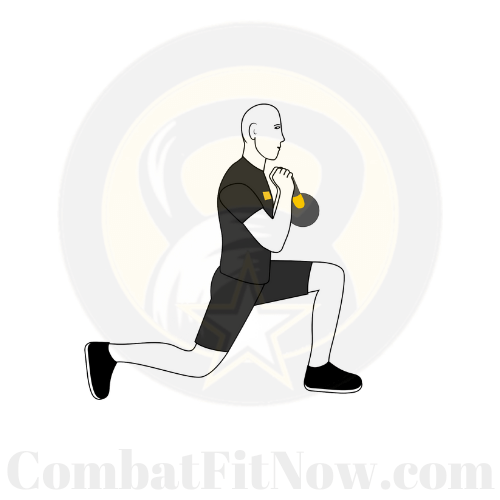Kettlebell lunges are a great exercise for targeting your legs, glutes, and core while also improving balance and stability. Here’s a step-by-step guide on how to perform kettlebell lunges:
Equipment Needed:
- Kettlebell of an appropriate weight for your fitness level.
Step-by-Step Instructions:
- Choose the Right Kettlebell:
- Select a kettlebell that is appropriate for your fitness level. Start with a lighter weight and gradually increase as you get more comfortable with the exercise.
- Stand with Proper Posture:
- Stand with your feet hip-width apart. Hold the kettlebell with both hands in front of your chest, keeping your core engaged.
- Take a Step Forward:
- Take a controlled step forward with your right foot. Your knee should be directly above your ankle, and your left knee should hover just above the ground.
- Lower Your Body:
- Lower your body straight down, bending both knees. Ensure your back is straight, and your chest is up. This movement engages your quadriceps, hamstrings, and glutes.
- Push Back to Starting Position:
- Push off with your right foot to return to the starting position. Bring your right foot back to meet your left.
- Alternate Legs:
- Repeat the lunge on the opposite leg by stepping forward with your left foot. Keep alternating legs for the desired number of repetitions.
- Maintain Control:
- Throughout the exercise, focus on maintaining control and balance. Avoid rushing the movement to ensure proper form and reduce the risk of injury.
- Breathing:
- Inhale as you step forward and lower your body.
- Exhale as you push back to the starting position.
- Repetition and Sets:
- Start with a moderate number of repetitions (e.g., 10-12 on each leg) and perform multiple sets. Adjust the repetitions and sets based on your fitness goals.
- Safety Tips:
- Be mindful of your knee alignment; it should not extend beyond your toes.
- Keep your core engaged throughout the exercise to support your lower back.
- Choose a weight that challenges you but allows for proper form.
Always consult with a fitness professional or healthcare provider if you have any concerns about your ability to perform specific exercises, especially if you have pre-existing health conditions or injuries.
Kettlebell Lunge Walk
The kettlebell lunge walk is a dynamic exercise that targets various muscle groups, including the legs, glutes, and core. Here’s a step-by-step guide on how to perform the kettlebell lunge walk:
Muscles Worked:
- Quadriceps
- Hamstrings
- Glutes
- Core muscles
Equipment:
- Kettlebell
Instructions:
- Choose the Right Kettlebell:
- Select a kettlebell with an appropriate weight for your fitness level. Beginners may start with a lighter kettlebell and gradually increase the weight as they become more comfortable with the exercise.
- Proper Stance:
- Stand with your feet hip-width apart, and hold the kettlebell in a goblet grip. This grip involves holding the sides of the kettlebell close to your chest with both hands.
- Engage Your Core:
- Tighten your core muscles to maintain stability throughout the exercise. This will help protect your lower back and improve balance.
- Take a Step Forward:
- Begin by taking a step forward with one leg. Ensure that your stride is long enough to create a 90-degree angle at both knees when you lower your body.
- Lower Your Body:
- As you step forward, lower your body into a lunge position. Your back knee should come close to, but not touch, the ground.
- Maintain Proper Form:
- Keep your torso upright, and make sure your front knee is directly above your ankle. Avoid leaning too far forward or backward.
- Push Off:
- Push off the front foot to return to the starting position. Bring your back foot forward to meet the front foot.
- Repeat on the Other Leg:
- Perform the same sequence of movements with the opposite leg, taking a step forward, lowering into a lunge, and then returning to the starting position.
- Continue Walking:
- Continue walking forward, alternating legs with each step. Aim for a smooth, controlled movement.
- Complete the Set:
- Perform the exercise for a specified number of repetitions or a set distance, depending on your fitness goals.
Tips:
- Focus on maintaining good posture and balance throughout the exercise.
- Keep your movements controlled to avoid unnecessary strain on your joints.
- Start with a lighter kettlebell if you’re new to this exercise, and progressively increase the weight as you get stronger.
As always, it’s advisable to consult with a fitness professional or healthcare provider before starting a new exercise routine, especially if you have any existing health concerns or conditions.

